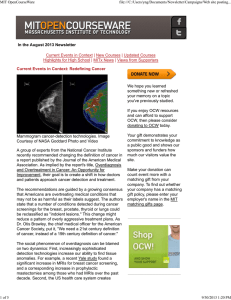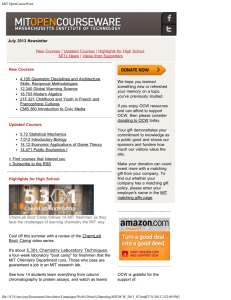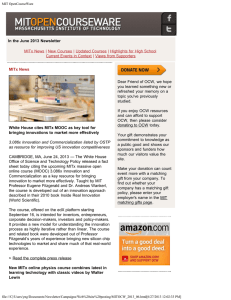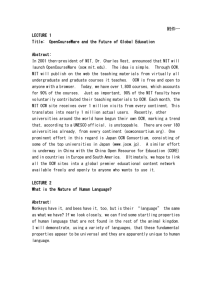April 2013 Newsletter
advertisement
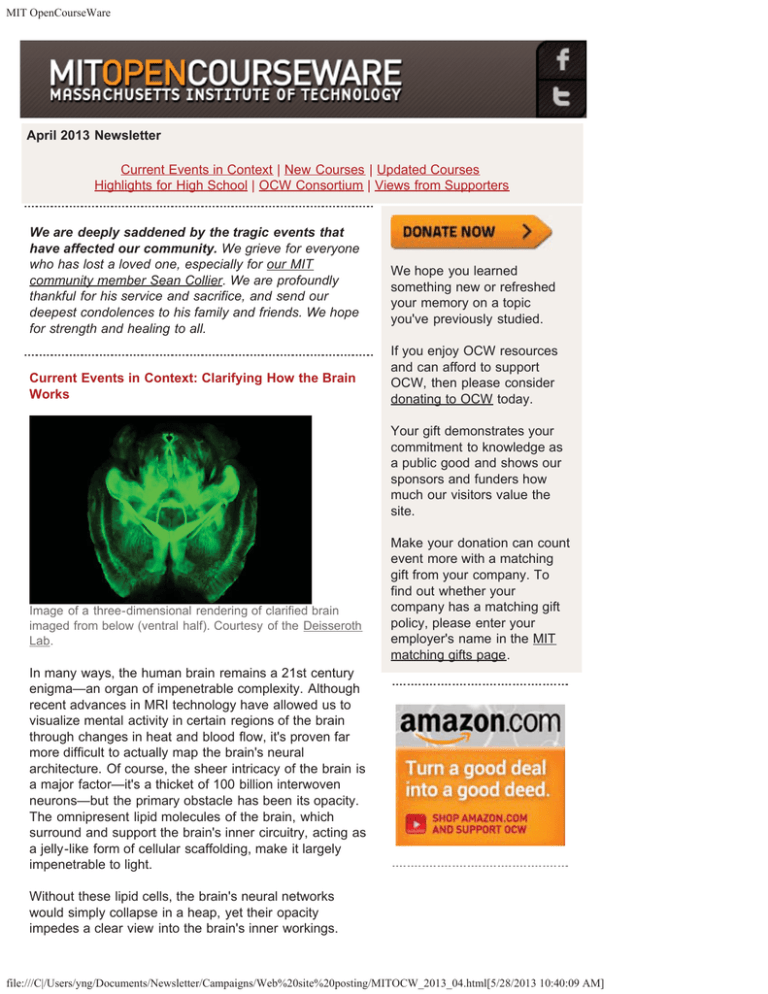
MIT OpenCourseWare April 2013 Newsletter Current Events in Context | New Courses | Updated Courses Highlights for High School | OCW Consortium | Views from Supporters We are deeply saddened by the tragic events that have affected our community. We grieve for everyone who has lost a loved one, especially for our MIT community member Sean Collier. We are profoundly thankful for his service and sacrifice, and send our deepest condolences to his family and friends. We hope for strength and healing to all. Current Events in Context: Clarifying How the Brain Works We hope you learned something new or refreshed your memory on a topic you've previously studied. If you enjoy OCW resources and can afford to support OCW, then please consider donating to OCW today. Your gift demonstrates your commitment to knowledge as a public good and shows our sponsors and funders how much our visitors value the site. Image of a three-dimensional rendering of clarified brain imaged from below (ventral half). Courtesy of the Deisseroth Lab. Make your donation can count event more with a matching gift from your company. To find out whether your company has a matching gift policy, please enter your employer's name in the MIT matching gifts page. In many ways, the human brain remains a 21st century enigma—an organ of impenetrable complexity. Although recent advances in MRI technology have allowed us to visualize mental activity in certain regions of the brain through changes in heat and blood flow, it's proven far more difficult to actually map the brain's neural architecture. Of course, the sheer intricacy of the brain is a major factor—it's a thicket of 100 billion interwoven neurons—but the primary obstacle has been its opacity. The omnipresent lipid molecules of the brain, which surround and support the brain's inner circuitry, acting as a jelly-like form of cellular scaffolding, make it largely impenetrable to light. Without these lipid cells, the brain's neural networks would simply collapse in a heap, yet their opacity impedes a clear view into the brain's inner workings. file:///C|/Users/yng/Documents/Newsletter/Campaigns/Web%20site%20posting/MITOCW_2013_04.html[5/28/2013 10:40:09 AM] MIT OpenCourseWare Thus, until now, mapping the brain meant working with slices of tissue samples that were thin enough to let light through, and digitally piecing them all back together—a complex exercise with significant limitations. Last week, however, a team of researchers at Stanford University accomplished what H.G. Wells imagined more than a century ago in his novella, The Invisible Man, by rendering the brain's tissue almost completely transparent. Here's how it works: The brain is soaked in a transparent hydrogel that permeates the brain tissue, binds to all its cells except the lipids, and forms a kind of supportive mesh. Then scientists use a precise combination of chemicals and electrical charge to heat and flush out the lipid cells. The hydrogel replaces the lipid cells, rendering the brain tissue almost completely transparent, while the nerve networks remain entirely intact. OCW is grateful for the support of: Combined with a parallel technique that uses fluorescent pigments to light up targeted cells, scientists can now highlight either a single neuron, or see an entire threedimensional system of nerve cells within the brain, without disturbing the surrounding tissue. It's hoped that this breakthrough will allows scientists to closely study anomalies in the brain's architecture that might be related to diseases like schizophrenia, autism, Alzheimer's or Parkinson's disease. The discovery closely follows the Obama Administration's recent announcement of a major federal initiative to comprehensively map the human brain, and it will undoubtedly speed things along. It's widely believed that mapping and understanding the neural networks of the human brain could have as influential and explosive an impact on medical science as when the Human Genome Initiative allowed us to document the entire human DNA sequence. OCW has a rich array of courses covering the brain's anatomy and our ability to visualize its inner workings. The following topics are just a small sample: MIT Notice 22.058 Principles of Medical Imaging surveys the physics and engineering techniques that permit a whole range of methods for imaging the body, such as x-rays and MRIs. 7.341 Brightening up Life: Harnessing the Power of Fluorescence Imaging to Observe Biology in Action covers the discovery and use of fluorescent imaging to highlight a broad variety of chemical processes in the body. 9.97 Introduction to Neuroanatomy is a course designed to help ground students in the brain's anatomical structures and its three-dimensionality. file:///C|/Users/yng/Documents/Newsletter/Campaigns/Web%20site%20posting/MITOCW_2013_04.html[5/28/2013 10:40:09 AM] MIT OpenCourseWare 9.14 Brain Structure and its Origins presents an outline of mammalian functional neuroanatomy and brain development. New Courses 4.210 Precedents in Critical Practice 6.S096 Introduction to C and C++ Updated Courses 6.003 Signals and Systems CMS.801 Media in Transition > Find courses that interest you > Subscribe to the RSS Highlights for High School MIT runs a surprising number of outreach programs for high school students that cover every topic imaginable from the science of baseball to entrepreneurship . You can see examples of courses from these programs on Highlights for High School in the "High School Courses Developed by MIT" section. If you’re looking for a summer program for a high school student, we recommend you take a look at MIT's Outreach Directory. OCW Consortium: OpenEd Conference The OpenEd conference was an important incubator for the OpenCourseWare Consortium in the early going (2004-2007) and is one of the great open education conferences each year. This year is its 10th anniversary and will be held November 6-8, 2013 in Park City, Utah. To find out more about the conference and the open call for papers, visit the site at http://openedconference.org/2013/. Views from Supporters file:///C|/Users/yng/Documents/Newsletter/Campaigns/Web%20site%20posting/MITOCW_2013_04.html[5/28/2013 10:40:09 AM] MIT OpenCourseWare "I'm so impressed with the quality of the material being made available to learners wherever they are in the world. This open model for education is a transformational force in our era. We must all support this. This is the ultimate tool to empower impoverished communities. Forget just giving the fish, give us the opportunity to learn how to fish. Thank you." - Margaret, Independent Learner, USA > Read more Tell us what you think of OCW at ocwfeedback@mit.edu. > Privacy and Terms of Use MIT OpenCourseWare is located at: One Broadway, Cambridge, MA 02142 file:///C|/Users/yng/Documents/Newsletter/Campaigns/Web%20site%20posting/MITOCW_2013_04.html[5/28/2013 10:40:09 AM]
